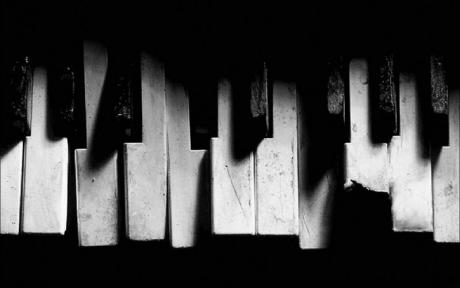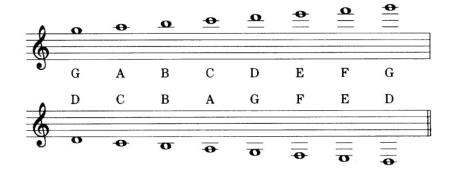Rockové klávesy - Noty
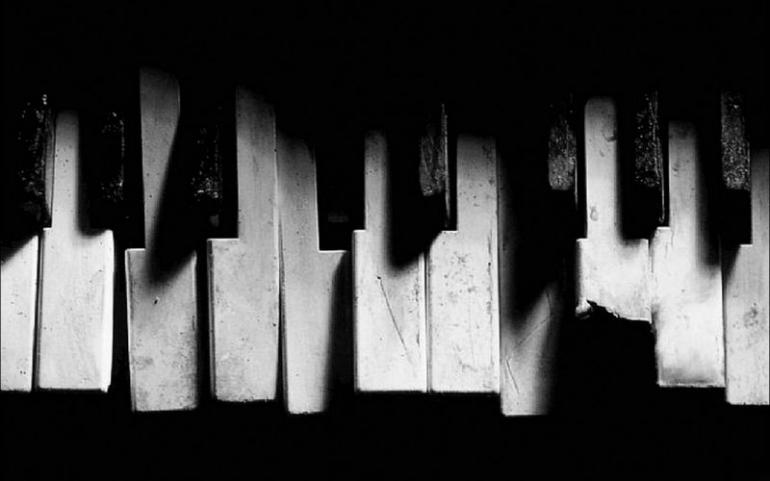
Welcome Readers! I hope you enjoyed last months article on early electronic instruments. This month I wanted to continue on a topic we started two months ago, sight reading. In the first article of the series, we spoke about reading rhythms. This month I wanted to speak about reading notes and chords. Let’s dive right in.
Spaces and lines
Take a look at Ex #1. As you can see there are four word tricks for remembering the names of the lines and spaces on the staff. The two treble clef tricks are the most well know. We call bar 1 “space face” for notes in the spaces of the top clef. In bar 2, Every Good Boy Does Fine. The first letter of each word yields the note name of the lines in the treble clef. The bass clef also has two word tricks for remembering the note names. Once you find any note on the clef, notes go up or down in step or 1/2 step as they alternate line, space, line, space in a very logical way. It’s good to just memorize these notes in the staff so reading them becomes second nature.
Above and Below the Staff
The notes move in the same ways as they go above and below the staff. Take a look at Ex #2a, as you can see we draw shorter lines above and below the staff that mimic the behavior of the regular staff. the notes still move in the same ways, line, space, line, space corresponding to a step in the scale. I find it helpful to use visual devices to remember the notes; for instance the lines making up the E above the staff looks like the letter E if you draw a line on the left side of the lines. Ex #2b has the bass clef version of the chart. If you haven't noticed by now, the bass clef functions the same way as the treble but the notes are displaced by a third. For example, the B above the staff in the bass clef would be a G in the treble clef and the F below the staff in the bass clef would be a D in the treble clef.

Key signatures
As you probably know, music is just not in the key of C. It’s important to look at the key of a piece before trying to read a tune. In Ex #3 the keys are listed in the circle of 5th, adding a sharp or flat as it moves through the keys. the accidentals are placed on the corresponding line or space. I like to memorize these just like the notes. A great way to get fast at reading in bad keys is to practice reading in them. Inventions and Sinfonias and Well Tempered Klavier are the best resources for this development. The Inventions are easier; so start there first.
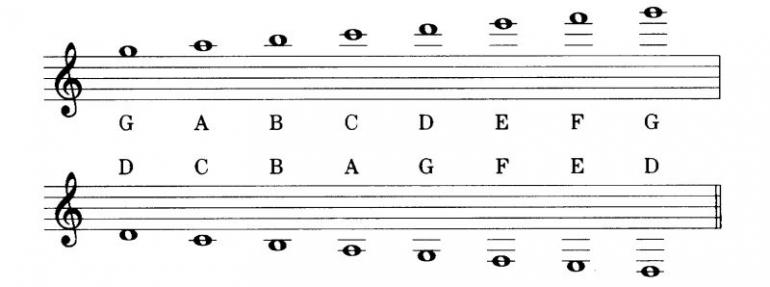
Inversions
Another skill that comes in when sight reading, is the ability to see when a triad is in root position, first inversion, or second inversion. Look at Ex #4 bar 1, this is a C Major triad in first inversion. Notice that the bottom two notes form an interval of a third. the distance between the G and C is a 4th. Being able to spot these intervals quickly is really important; a lot of fast sight reading is about recognizing patterns and being a good at guessing the right chord. The A minor chord in bar 2 has a 4th interval below a 3rd indicating a triad in 2nd inversion. Bar 3 F root position and all third intervals. Look fast at the last bar and guess the inversion of the last chord.
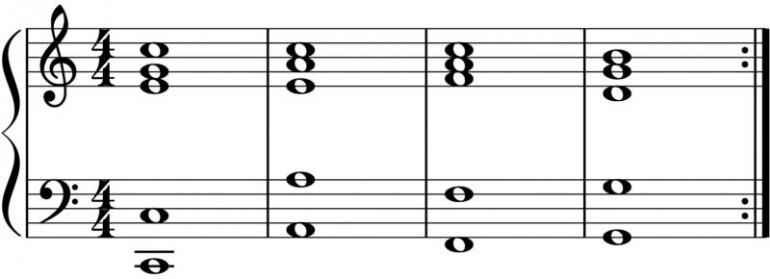
Putting it together
By combining the information in this article with the rhythm article form two months ago, you should be able to read almost any piece of music. Start getting your hands on all types of music and read through it very very slowly; slow enough so you can play it perfectly the first time. this might be very slow at first. As you get better at the skill, speed up the the tempo a little. Try to have lots of music around so you don't get too familiar with the pieces. In no time you will be a sight reading session ace!
Fráze a hudební termíny:
Treble clef, bass clef: Jedná se o houslový a basový klíč.
Staff: Možná znáte toto slovo ve významu „personál“ či „zaměstnanci“. V hudební terminologii však znamená „osnova“, tak se nenechte zmást!
Every Good Boy Does Fine: Mnemotechnická pomůcka, kterou Brian používá pro snazší zapamatování si not, které leží na linkách notové osnovy (odspoda nahoru). První písmeno každého slova je názvem daného tónu. Jen připomínám, že to, čemu se v mezinárodním systému říká nota b, se v české kotlině zpravidla nazývá nota h. Stejně funguje také slovo FACE, jehož jednotlivá písmena jsou názvy tónů v mezerách (opět odspoda).
Displaced by a third: Posunutý o tercii. Brian mluví o basovém klíči.
Circle of 5ths (fifths): Kvintový kruh (resp. kvartový a kvintový kruh) je velmi užitečná pomůcka, díky které se můžeme snáze orientovat v jednotlivých tóninách či harmonických funkcích. Ty jsou znázorněny (jak jinak než) v kruhu. Mimo jiné tak snadno poznáme, jak postupně přibývají křížky a béčka v předznamenání.
Sharp, flat: Křížky a béčka, tedy noty o půltón zvýšené, resp. snížené. Pozor, v obecnějším smyslu je tím myšlen také jakýkoli vyšší nebo nižší tón (nejen o půltón). Např. když máme nástroj rozladěný a daný tón je vyšší, než by měl být, označíme jej za „sharp“.
Inversions (first and second inversion): Obraty akordů. V kvintakordu může dojít k tomu, že pořadí tří základních tónů „prohodíme“. Nejnižší notou pak není tónika, tedy základní tón, ale jeden ze dvou zbylých. Podle toho se pak jedná o první nebo druhý obrat.
